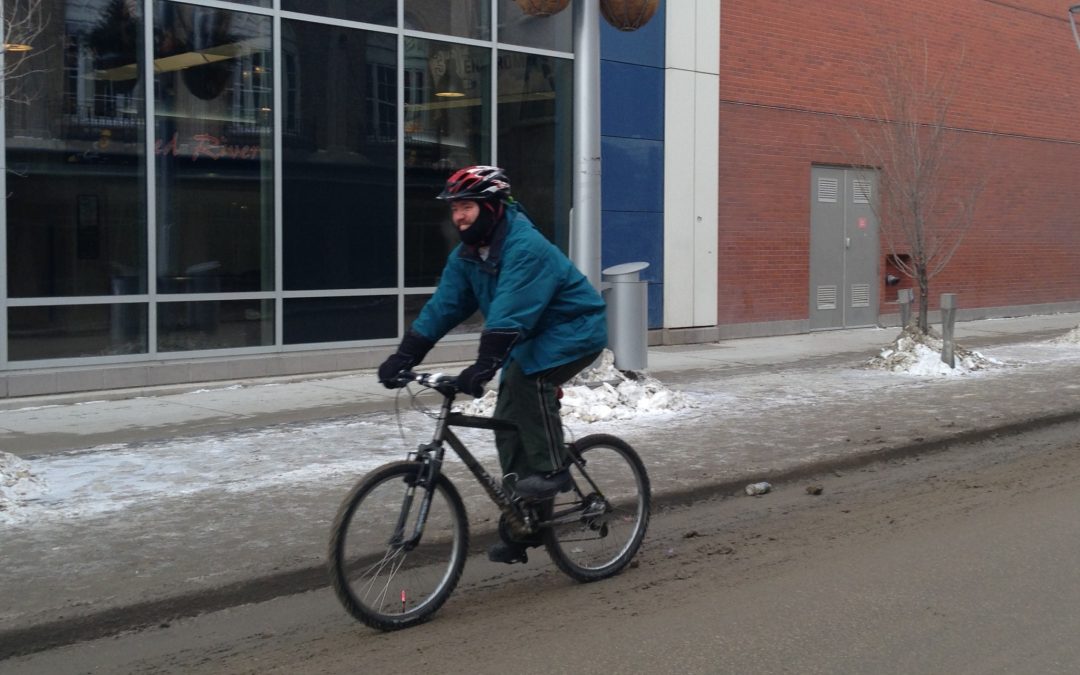Setting Up for Winter Biking
I was excited to try winter biking, but let me be clear that I’m not very eager to freeze my buns off. My bike, in winter, is a vehicle to get from point A to point B – preferably with both A and B being warm and indoors! Cycling is one of my three ways to get to work: bike, walk, and bus. I pull out my bus pass when it gets just too cold to face the wind for half an hour.
Before this winter, I lived more than 12 kilometers from work by bike (I recently moved). This trip took me 45 minutes in the summer time, making me a decidedly fair-weather cyclist. If you’re considering bike commuting, decide how much time you’re willing to spend in the saddle. If it’s too far for your comfort zone, consider things like biking one way and bussing the other (alternating each day), or biking to a station, storing your bike, and finishing the trip on the bus. You don’t have to go all-out to start gaining confidence with new commuting modes!
Get Your Gear
Do you ever bike in the summer? Great, you have most of the gear you need to bike in the winter! The main things you’ll need to add are warmer warmer clothing and more visibility options.
You’ll need:
- a rear flashing red light
- a front white light to both be seen by oncoming traffic and see the road conditions ahead
- a way to keep your head or ears warm under your helmet (or over it)
- whatever winter gear you feel most comfortable in
- Chain cleaner and “dry lube” (winter-appropriate grease for your chain)
I recommend making sure you have very warm and wind resistant mittens as your hands will get colder biking than walking. Your thighs will also get colder biking than walking, but you’ll probably build up some good core heat, so keep that in mind. You’ll want to clean off your chain once a week as winter riding introduces lots of water and salt to the mechanical parts of your bike, wearing them down very quickly.
Plan Your Route
What time will you be commuting? If you’re going in the dark, bring lights and reflective gear. I recommend a safety vest because as much as it’s the job of cars to watch out for us, it’s just smart to make it easy for them. Are you going on streets or routes without much lighting? Make sure that you get a very bright light for your front handlebars: you’ll need it to safely navigate, not just alert cars to your presence!
When you’re planning how to get to work, you absolutely do not have to stay on designated bike routes. However, if you’re new to winter cycling, you may want to take designated bike or less-trafficked routes. Need a map? Green Action Centre stocks Winnipeg bike maps and Winnipeg Trails has a great resource: http://www.winnipegtrails.ca/trails-maps/
My Experience
I’ve only just started, but I have some initial impressions. There’s a few things that are making winter cycling work for me, and a few things making it difficult. First, the challenges:
- I actually live TOO conveniently to work. It only takes me 30 minutes to walk to work, and about 20 minutes to bus. Biking is quick, but requires hauling it up from my basement bike room and making sure it’s properly locked at either end of my commute.
- Bike parking challenges. My apartment has a bike room, which is excellent, but it’s awkward to use and over-crowded. The building we work in has outdoor bike parking available only, and uses half the bike rack for snow storage in the winter. (P.S. if you want to help your workplace improve the cycling culture and infrastructure, check out how our Workplace Commuter Options program can help!)
But, I have a lot of advantages:
- Living close enough to work that biking isn’t an hour-long expedition.
- Bike infrastructure! I am lucky to get to use bike lanes, even separated ones, for almost all of my commute. It’s not perfect, but they help me to feel safer. If you don’t have cycling infrastructure on your commute, contact your city councillor and advocate, or get involved with Bike Winnipeg
- Supportive friends. Nobody freaked out when I said I would try winter biking, and I had support from friends to pick out a winter bike (Thanks Dave!). My workplace also encourages these choices! (Want to change your workplace cycling culture? We can help!)
- Community bike shops. We all have this advantage in Winnipeg, and we should be using them! You can get refurbished/recycled bicycles for very affordable prices, and have the benefit of volunteer help with repairing and maintaining your bike.
Why on Earth am I doing this??
Why am I winter biking? I want to:
- Laugh in the face of winter
- Work different muscle groups than sitting on the bus, or walking
- Not have to check bus schedules
- Go super low-carbon in my commute (even bussing produces GHGs!)
- Be in shape for summer biking
- Get places faster than I can walk
- Rack up points in Jack Frost Challenge!




Recent Comments